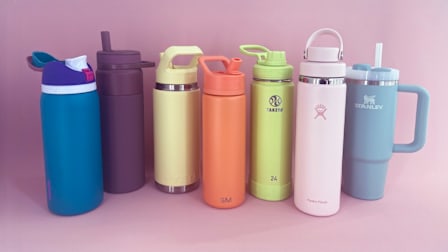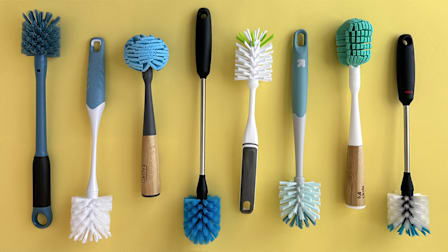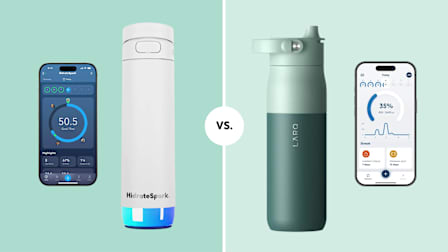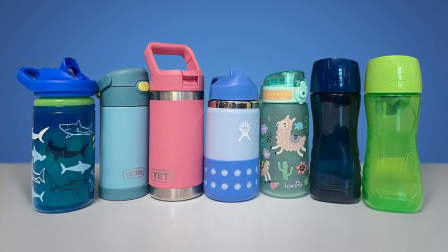All the Reasons I Love and Hate the Air Up Water Bottle
Plus, I figured out why so many people on Reddit dump on this product—and what they might be doing wrong
When you shop through retailer links on our site, we may earn affiliate commissions. 100% of the fees we collect are used to support our nonprofit mission. Learn more.
I am chronically on the internet so I see a lot of trends, gimmicky products, and weird hacks every day. I am also very easy to influence into trying something new, which is why I know about and own an Air Up water bottle.
If you haven’t heard, they’re one of the latest crazes in the world of hydration that claims to trick your brain into thinking you’re drinking flavored water through the use of scented pods. It’s currently so popular with school-age kids that my colleague’s son pitched it as the replacement for Stanley tumbler during a recent car ride home.
Videos on social media about the bottle have thousands of views and they’ve even inspired some copycat brands selling similar bottles for a fraction of the cost of the original.
How Does the Air Up Work?
The Air Up water bottle is possible because of something called retronasal smell. According to the journal JAMAOtolaryngology—Head & Neck Surgery, this is “the perception of odors emanating from the oral cavity during eating and drinking, as opposed to orthonasal olfaction, which occurs during sniffing.”
In more basic terms, it’s the smelling you do when you’re eating and drinking your favorite foods. A small gap between the mouthpiece and the bottle creates pockets of air bubbles (it reminds me of sipping through a ripped paper straw) that carry the scent of the pods from your mouthpiece to your nasal cavity with each sip, allowing you to “taste” the pod’s scent, though you aren’t actually adding any flavoring ingredients to the water.
Your brain is being tricked into thinking that the scent you’re smelling is a flavor inside the water you’re drinking, thus you can taste the fruity smell. Jüngst said the idea behind the bottle is to promote consumer’s use of reusable bottles. It’s also an alternative to sugary drinks and the multistep concoctions social media users often share on #watertok, which sees users adding so many ingredients to their water that it probably shouldn’t even be called water anymore.
How Do You Use the Air Up?
First, you have to fill your bottle with water up to the marked line. Then, insert the straw in the mouthpiece and press down firmly until the mouthpiece sits snugly on the top of the bottle. Here’s the most important part of the setup process:
Place the scent pod on the mouthpiece to begin sipping scented water. If you slide the pod all the way down on the mouthpiece, you’ll get very little, if any of the pod’s “taste” because you’re blocking the hole in the mouthpiece that creates the pockets of air needed to carry the scent to your nasal cavity.
To activate the pod, you have to pull it up a bit, aligning the tiny mouthpiece hole with an equally small hole in the scent pod. How do you know if you’ve got the pod in the right spot? Take a sip from the bottle. If you hear and feel those loud, interrupting air bubbles in your sip, you’re good to go. No air bubbles means you need to adjust the scent pod.
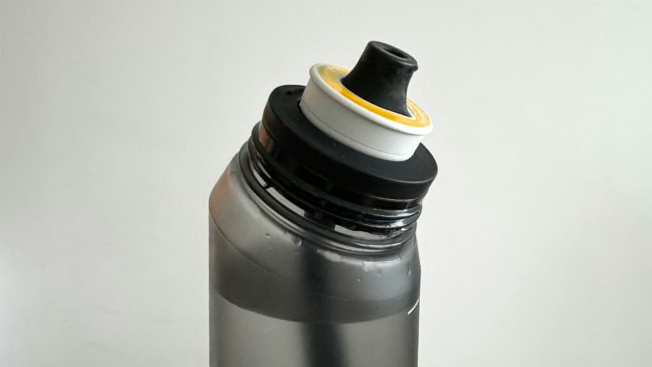
Photo: Jodhaira Rodriguez/Consumer Reports Photo: Jodhaira Rodriguez/Consumer Reports
Does the Air Up Really Work?
Online reviews of the Air Up water bottle are a mixed bag. For example, some people on Reddit think the Air Up works great and love it, while others call the water bottle a scam. (Do a web search on "Reddit Air Up water bottle" to see what they’re saying.) The company’s return policy, which doesn’t allow for the return of the bottle after it has been opened or used, is cited as further evidence of the bottle being a scam by some disgruntled users.
For me, the bottle worked, but anyone expecting a pop of flavor akin to a drink of their favorite juice or soda is going to be disappointed. The flavor isn’t anywhere near that intense. I think it’s less flavorful than the popular sparkling water whose flavor is so subtle, that social media users have joked it tastes like someone burped into the drink after eating a fruit salad. Many of the Air Up flavors I enjoy remind me of a drink of cold water after just chewing a piece of fruity gum or after eating a hard candy. It does not remind me of the oh-so-satisfying first sip from some of my favorite sugary drinks.
What I Like About the Air Up
There are plenty of tasty flavor options. I like having options and Air Up gives users plenty of flavors to choose from with 12 unique scents. I’m a fan of the fruity flavors like Mango-Passion Fruit and Apple, but the company also has some fun options like Cherry-Cola, Orange-Vanilla, and Ice Tea Peach that are tasty, too.
It’s easy to clean. The company doesn’t recommend washing the bottles in a dishwasher, which could be annoying for some. I don’t mind. The bottle’s parts disassemble easily and the straw brush I use for my reusable stainless steel straws is usually the only other tool I need besides my regular sponge and dish soap. There are some users online who have found black gunk in the mouthpiece of their bottles, but this is something that could happen with any reusable bottle that isn’t washed enough. I haven’t noticed any of this in my own bottle after about a year of irregular use.
It comes with an easy-to-carry strap. I love the strap on the Air Up bottle’s cap, in fact, it might be my favorite thing about the bottle. It’s sturdy and easy to carry when I travel with my bottle. Even if my hands are full, I can carry the bottle with just a finger looped through the strap without any trouble. Plenty of other popular bottles, including my trusty Thermos insulated water bottle and bottles from Hydro Flask also have convenient handles, so this isn’t a feature unique to Air Up.
Bottles are customizable. While I haven’t taken advantage of the customizable mouthpieces and straps the company offers, I appreciate that customization is an option. For $9.99 and $14.99, respectively, users can choose between nine different straps and eight different mouthpiece colors, plus seven different color options for the plastic bottle itself.
Where to Buy
Shop for the Air Up water bottle.
What I Don’t Like About the Air Up
Reassembling is difficult. I do not look forward to reassembling the bottle every time I refill or wash it. Attaching the mouthpiece to the bottle requires some significant force, and if you don’t get it on there just right, twisting the bottle’s cap on isn’t possible. It’s when I go to twist the cap on that I usually notice that the mouthpiece isn’t totally in place.
Air bubbles are annoying. While I know the company says the air bubbles are necessary for the flavor effects of the scent pods, it doesn’t make me hate the experience of interrupted sipping any less. A smooth, refreshing sip just isn’t possible because of the bubbles. Especially after an intense workout session when I’m desperately trying to gulp down water, I make sure to have the pod in its deactivated position (pushed all the way down) so that I don’t have to deal with the air bubbles. If you frequent a library with strict rules on silence, make sure to leave your Air Up bottle at home. Every sip while the pod is in the activated position is followed by short gurgling sounds as bubbles travel up the straw into the mouthpiece.
Pods are expensive, and their recyclability makes me nervous. All of the scent pods can be purchased in packs of three with prices ranging from $7.99 to $12.99. Considering I go through one pod every three to five days, a 30-day supply of my favorite, mango-passion fruit, could cost me anywhere from $25.98 to $43.30. I don’t use the Air Up bottle to try to curb an already expensive juice or soda habit, so I’m not saving any money by using the bottle over buying other drinks.
Going through that many pods every month also makes me worry about the amount of waste I’m creating. According to the company, the pods are recyclable, but Jüngst recognizes that their plastic makeup isn’t ideal. “Our pods are made of two types of plastic: the outer casing of the pods is made of polypropylene (PP). The carrier material, a type of fleece inside the pod that holds the natural flavors that provide our scent-based taste experience, is made of polyester (PE). Both are recyclable materials and are accepted by recycling programs that take type 1 and 5 plastics.” According to Jüngst, by September 2024, the pods will be made entirely from bio-based plastics, which are renewable materials.
Individual pods don’t have any recycling symbols on them, and I worry that even though I’m placing them in my recycling bin, they aren’t actually being recycled once they reach my local recycling facility. Paul Scott, CR’s director of product sustainability, told me I was likely right about my pods not being recycled currently. “Recycling infrastructure varies locally, it’s often hard to separate and recycle plastics in small packages, making them compostable, reusable or refillable might be something that the company would have more control over.”
The bottle is not leak-proof. Unlike some of the other water bottles we’ve evaluated, the Air Up water bottle is not leak-proof—something I’m reminded of every time I accidentally tip the bottle over. If I notice it quickly enough (within a second or two), I can usually turn the bottle right side up before water starts leaking out by the cap, then unscrew the cap over the sink to allow the water that has collected there out. But just a second too late and I end up wiping up spills all over the place. Because it isn’t leak-proof, I’ve never carried my bottle in my bag as I fear that it will tip over and damage my things.
The bottle doesn’t keep my water cold. Lastly, the Air Up bottle I have is not insulated. This isn’t too bad if I’m just using it at home where I can easily empty and refill it with fresh, cold water from my fridge, but it isn’t ideal when I’m traveling with the bottle. The Thermos bottle I use most often to drink water from is insulated so I can usually drink day-old water from it and still find that it keeps its cool temperature. Not the case with Air Up.
How Long Do the Air Up Pods Last?
According to Jüngst, each pod can be used to flavor “at least 1.3 gallons of water.” At home, I find myself switching out a pod about every three to five days usually (I use the 22-ounce bottle). Also keep in mind, if you want to stay stocked on pods, buying too many at a time could backfire as each three-pod pouch has a best-before date. I’ve found that if I keep my pods inside of the sealed pouches they arrive in, even those that are past their best-before date work well.
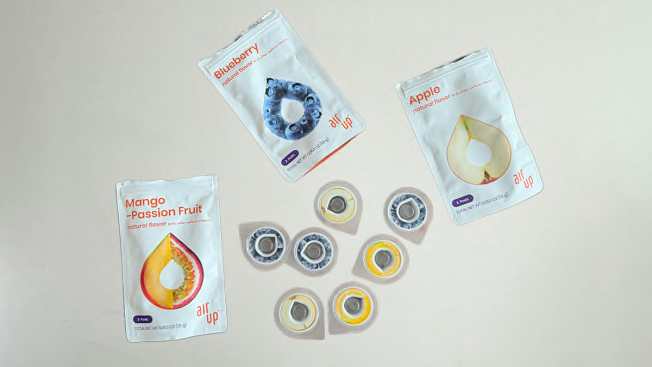
Photo: Jodhaira Rodriguez/Consumer Reports Photo: Jodhaira Rodriguez/Consumer Reports
Are Air Up Scent Pods Healthy?
One last thing to consider about the Air Up bottle is whether the scent pods are healthy. Sure, if you’re using it to replace sugary drinks full of questionable ingredients with water, it could be beneficial, but given the questions around the safety of fragrance in home products, should we worry about the use of fragrance in the scent pods? On its website, Air Up states that the pod’s scents are “derived from only natural ingredients, such as fruits, spices, and herbs” and Jüngst further told us the pods are “food safe and do not contain CMR (carcinogenic, mutagenic and reprotoxic chemicals) substances or declarable allergens.”
According to the Air Up site, the pods comply with the Food and Drug Administration’s Code of Federal Regulations, but our experts still had questions. Michael Hansen, PhD, CR’s senior scientist, said his concern is a loophole in the FDA’s Code of Regulations that he has been concerned with for years. “There’s a clause in the FDA’s rules that allows brands to take natural ingredients, ferment them, genetically engineer organisms, and still call them natural sources.”
Companies can also present evidence to the FDA to support their designation as Generally Recognized As Safe (GRAS), but this is a completely voluntary program. When we requested the file number (GRN No.) from Air Up for its GRAS notice, they told us, “Our flavors adhere to both European and American food laws, including GRAS and Prop 65 guidelines. Our aroma suppliers are responsible for ensuring adherence to these regulations, and we collaborate with them under the condition that compliance is guaranteed. However, we do not disclose specific documentation as this information is proprietary and highly confidential.” Because Air Up does not disclose its aroma supplier, we could not contact the fragrance manufacturer to confirm the pods’ GRAS designation.
An FDA spokesperson said they do not discuss specific products but shared the following: “The FDA does not approve food labels nor are food manufacturing firms required to provide the FDA with a list of food ingredients. It is the firm’s responsibility to ensure that product labeling and ingredients comply with the FDA’s regulations.
In addition, the GRAS or food additive status of a flavor intended for use in food is not relevant to other intended uses (e.g., inhalation).” Basically, a company informs the FDA that it is compliant with the agency’s regulations, but the FDA does not perform its own investigation into a company’s purported ingredients in the GRAS notification process. Further, a GRAS designation does not cover an additive’s safety as it is inhaled, only as an ingredient being consumed as food.
James Rogers, CR’s director of food safety, said that even if the aroma extracts are being diffused in very small amounts, they must be food-grade safe (Air Up says they are). And, he thinks it’s important to disclose what exactly is in the scent pods on the label. “I would tend to want to know what is in there myself, just to be sure.” Scott echoed this sentiment on transparency, calling it a “key element of sustainability.”
One final area of concern according to Hansen, is whether any chemicals in the polyester material inside of the pods are being leached out as the flavors are inhaled. “In the presence of heat, polyester can leach acetaldehyde, which is a known carcinogen.” On its site, Air Up advises users to “store flavor pods in a dry and cool place.”
@consumerreports The future of drinking water? The Air Up bottle tricks your brain into thinking you’re drinking flavored water. See more at the link in bio. #water #waterbottle #airup
♬ original sound - Consumer Reports

















